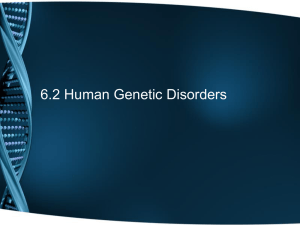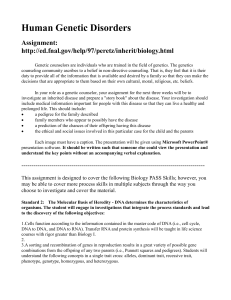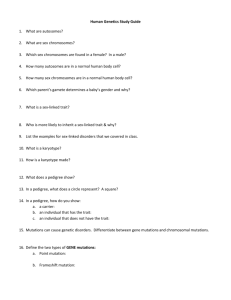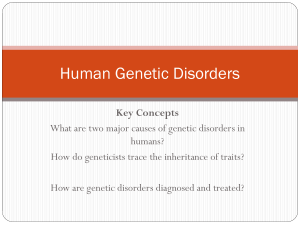Genetics Lesson Plan
advertisement
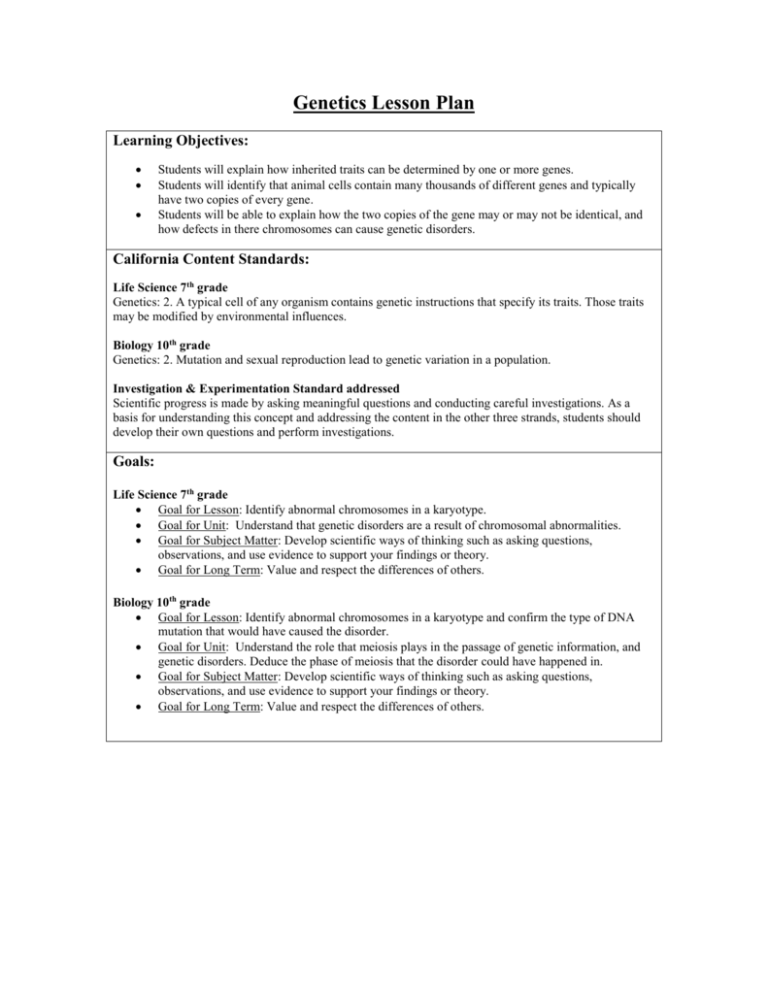
Genetics Lesson Plan Learning Objectives: Students will explain how inherited traits can be determined by one or more genes. Students will identify that animal cells contain many thousands of different genes and typically have two copies of every gene. Students will be able to explain how the two copies of the gene may or may not be identical, and how defects in there chromosomes can cause genetic disorders. California Content Standards: Life Science 7th grade Genetics: 2. A typical cell of any organism contains genetic instructions that specify its traits. Those traits may be modified by environmental influences. Biology 10th grade Genetics: 2. Mutation and sexual reproduction lead to genetic variation in a population. Investigation & Experimentation Standard addressed Scientific progress is made by asking meaningful questions and conducting careful investigations. As a basis for understanding this concept and addressing the content in the other three strands, students should develop their own questions and perform investigations. Goals: Life Science 7th grade Goal for Lesson: Identify abnormal chromosomes in a karyotype. Goal for Unit: Understand that genetic disorders are a result of chromosomal abnormalities. Goal for Subject Matter: Develop scientific ways of thinking such as asking questions, observations, and use evidence to support your findings or theory. Goal for Long Term: Value and respect the differences of others. Biology 10th grade Goal for Lesson: Identify abnormal chromosomes in a karyotype and confirm the type of DNA mutation that would have caused the disorder. Goal for Unit: Understand the role that meiosis plays in the passage of genetic information, and genetic disorders. Deduce the phase of meiosis that the disorder could have happened in. Goal for Subject Matter: Develop scientific ways of thinking such as asking questions, observations, and use evidence to support your findings or theory. Goal for Long Term: Value and respect the differences of others. Day 1 Warm-up: As a review from a previous lesson, students will individually write down the answer to the following question: In your own words, briefly explain how chromosomes separate during meiosis. You may draw each phase if you choose instead, however you must be able to label all parts of the cell involved. Use key terms to explain the process for each phase. Whole group discussion: After five minutes, students will be allowed to express one phase that takes place, while the teacher writes down the information on the overhead using an outline format. After all phases are correctly presented by the students, the teacher will display and review overhead transparencies of each phase to reinforce the concept. Lesson Question: To grab students’ interest in the subject matter, they will be asked the following questions: What do you think causes genetic disorders? Why do you think some people are more likely to have children with disorders than others? The whole class will brainstorm reasons and discuss. How many people have seen X-men? Although this was a science-fiction movie, how did the “normal” people feel about the mutants? Do you think you can find any connection between how the mutants were treated in the movie and how people with genetic disorders may be treated in reality? The whole class will brainstorm reasons and discuss. Introduction to Activity: Students are introduced to the concept and background of karyotyping, along with its relationship to genetics. Based on information previously presented, students already share an understanding of the concepts relating to cell division, chromosomal replication, DNA, and genetic engineering. Power point presentation is used to show a series of “real life” karyotypes. During the presentation, students are given a power point worksheet in order to take notes. Activity Preparation: Classroom reading assignment: Grouped in fours, each student will be assigned one of the four genetic disorders discussed in class. Students will then be asked to answer the following questions about their genetic disorder: o What is the cause of this disorder? o What are the symptoms? o What defect does this disorder cause? o How common is this genetic disorder? o Is this disorder dominant, recessive, sex-linked? o What additional information did you find interesting? Students will then “jigsaw” and present the information to each member in their group of four. Finally students’ will present their understanding of these genetic disorders as a whole group discussion, responding to the questions above. Take home assessment: Writing Prompt- Individually, students will respond to the following question: Do you think that the ability to view a person’s karyotype is an effective technique that could be used to cure genetic disorders? Based on your previous knowledge of genetic engineering, explain techniques scientists can use to possibly cure these disorders, and the moral and ethical dilemma of when these techniques should be used. The response must be written as a two-paragraph essay. Day 2 Warm-up: Students will be asked to volunteer their responses to yesterday’s writing prompt. Each student should be able to explain techniques scientists could use to possibly cure genetic disorders. A review of these techniques will be presented by the teacher using overhead transparencies, to visually demonstrate the methods expressed. This will lead us into our whole group discussion. Pair-Lab 1) Each group is provided with a karyotyping package which includes the following materials: Karyotype Layout Worksheet Human Karyotypes Answer Key A Karyotype Scatter Sheet Human Birth Defects Resulting in Chromosome Disorders (4 various disorders) Chromosome Disorder follow-up questions 2) Students that require higher level reasoning skills and more in depth challenge are provided karyotype packages that involve the sex chromosomes. All other students are given karyotype packages that do not contain sex-linked disorders 3) Students are directed to color (7th grade) and cut out the chromosomes on their scatter sheet. They must place the chromosomes in the proper order on their layout worksheet according to the information provided from their answer key. 4) Once all chromosomes are in place, students will compare their karyotype layout with the one provided on the answer key. Students will be encouraged to observe and note any discrepancies between the two worksheets. 5) Students will compare and confirm their observation with their partner before proceeding to the Chromosome Disorder questions provided in their packets. Teacher will help encourage student pairs that are experiencing difficulty by asking questions that would force them to re-evaluate the answer key and their results. A possible question could be, looking at each Group and not individual chromosomes can you spot any differences between your sheet and the answer key? 6) Next, students will answer the Chromosome Disorder Questions provided, using the four chromosome disorder worksheets provided in their packet. Taking into consideration the symptoms of a child born with this disorder, do you think it would be immoral for parents to allow excessive genetic testing on their child in order to find a cure? Explain your answer and support your claim with scientific evidence.
